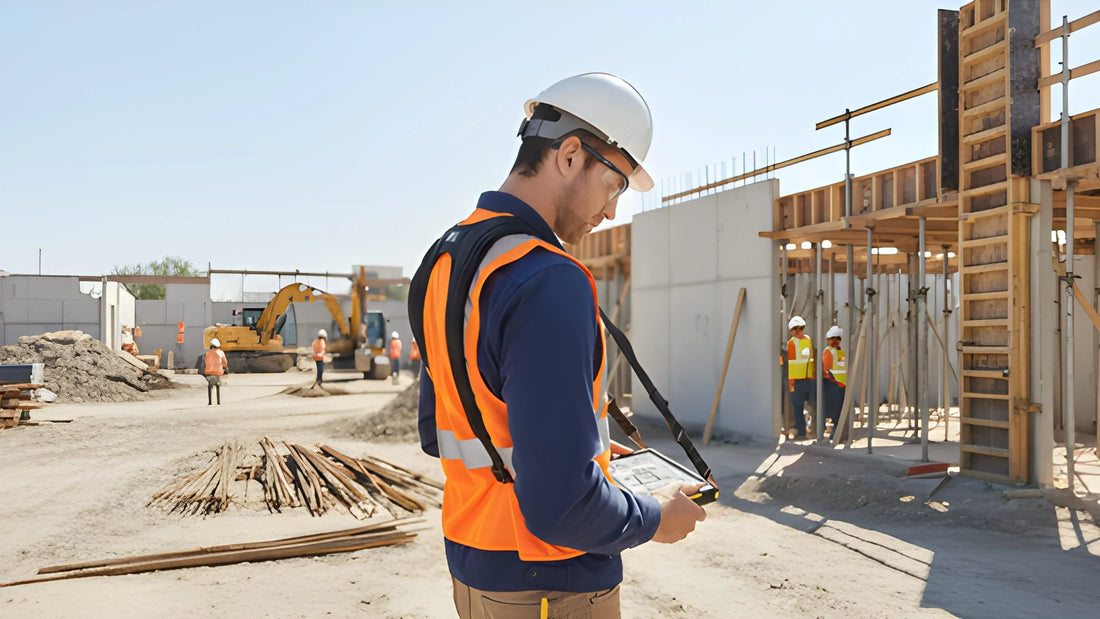
How Field Crews' Use of Tablets Is Creating Musculoskeletal Injury
Field tech has come a long way. Rugged tablets and mobile apps have replaced clipboards and binders. But the way we carry and use that tech hasn’t caught up.
For crews in construction, surveying, utilities, mining, forestry, and inspections a tablet computer has become an essential tool—but without gear that protects their body while using it. The result? A growing wave of neck, shoulder, and upper back injuries we should have seen coming.
The Problem Starts with Posture
The term “tech neck” was coined to describe a new kind of chronic strain: forward head posture, rounded shoulders, and cervical stress from constant downward screen viewing. It’s not just an office issue anymore.
As discussed in the 2025 article “Addressing “Tech Neck” In Musculoskeletal Disorder Prevention” by PROergonomics, smart phones and tablets used on job sites have the potential to add strain to already physical work.
When a tablet is held in one hand, or slung low on a neck strap, it pulls the body out of alignment. Over a full shift, that stress accumulates. Over a season? It turns into injury.
A 2023 literature review in the “International Journal of Industrial Ergonomics”, examined how posture and muscle strain change with the use of smart devices. A failure to maintain a neutral body position can lead to Musculoskeletal Disorders. You can read the abstract here.
This is consistent with what we hear from field users before they use our “Ruxton Pack”. When a tablet is held in a position that is comfortable for their arms and hands it forces their neck out of a neutral position. Typically, field users of tablets will hold the device close to their chest. Viewing the tablet in this position for extended periods of time can lead to significant neck and upper back pain.
Improvised carry solutions don’t help. Shoulder slings, survey vests, neck straps, hand straps or satchels do not address this issue as the user still has to hold the device in one hand while performing data entry with the other. None of these solutions support a neutral posture.
And on top of this many field users must carry other essentials-i.e. food, water, survival gear and other “tools of the trade”. Carrying all of this in a survey vest has never been a comfortable solution. As one experienced field surveyor stated, “the only time a vest is comfortable is when there is nothing in it”. Having worked as a forester on Canada’s West coast for many years I would have to agree with that!
Carrying Tech Shouldn’t Hurt
Shoulder straps are not an ergonomic solution for carrying tablets. Sling bags weren’t built for inspections. Survey vests were not designed for larger tablets. And no one should be climbing a ladder with a $3,000 tablet swinging from their shoulder.
Crews are improvising because the industry hasn’t offered better. But improvising leads to strain—and strain can lead to long-term injury.
“When workers are reporting back pain, fatigue, and numbness after carrying a tablet computer—those aren’t signs of weakness. They’re signs of unsafe design.”
– Brian Saunders, Fitek Gear
There’s a Better Way
Ergonomic carry systems change how crews interact with their tools. Proper posture. Balanced load. Hands-free stability. A secure setup that protects both worker and equipment.
At Fitek Gear, we’ve seen the shift: once teams switch to our chest-mounted tablet harnesses, the feedback is immediate—less shoulder pain, better posture, faster workflow. “Super Comfortable is almost always what we hear! Who would ever say that about a Survey Vest, satchel or shoulder strap?
Our Ruxton Pack allows the user to move the tablet away from their body to position that is ideal for viewing and data entry. Because the tablet is fully supported both hands can be used for data entry which improves productivity.
In addition, our gear keeps all the essential field gear close at hand. Field crews can customize our harness by adding pockets, pouches, and holsters to securely carry all the required equipment comfortably. When additional carrying capacity is needed a backpack can be added and worn on top of the chest pack harness-comfortable for a full day in the field!
Equip your field staff with an ergonomic carry solution for all their mission critical equipment. Reduce strain, fatigue, prevent injury and increase productivity by providing field crews with a modern field carry solution.
If your field staff are using tablet computers, it’s time to think ergonomics.
See what an ergonomic carry solution looks like in this video.
